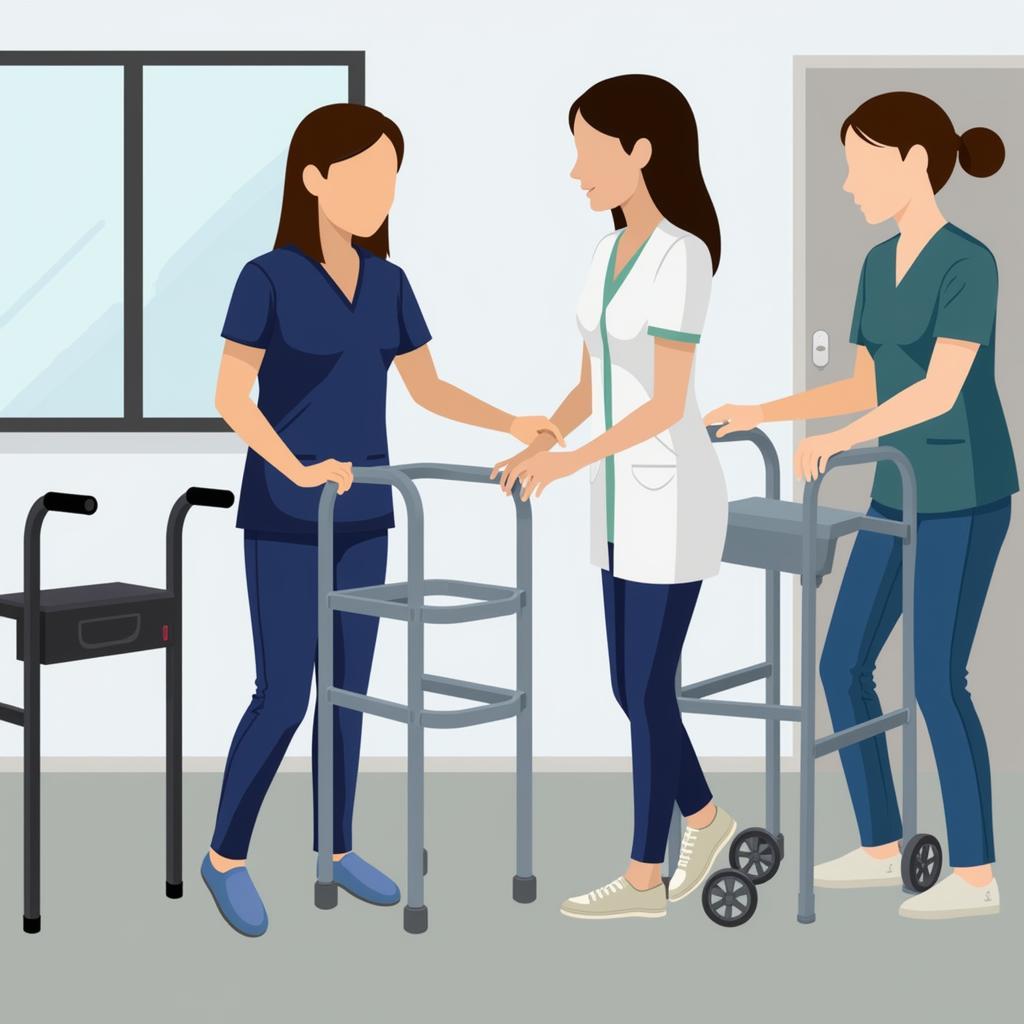Hospital Walkers are essential mobility aids for patients recovering from surgery, injury, or illness. They provide stability and support, allowing individuals to regain their independence and move around safely. Choosing the right hospital walker can significantly impact a patient’s recovery process. Let’s explore the different types of hospital walkers, factors to consider when selecting one, and how to use them effectively. hospital walkers
Types of Hospital Walkers
Several types of hospital walkers cater to different needs and preferences. Understanding the distinctions between them can help you make an informed decision.
Standard Walkers
Standard walkers are the most basic type, featuring a rectangular frame with four legs. The user lifts the walker, moves it forward, and then steps into the frame. This type of walker offers excellent stability but requires some upper body strength.
Two-Wheeled Walkers (Rolling Walkers)
Two-wheeled walkers have wheels on the front legs, allowing the user to roll the walker forward instead of lifting it. This reduces strain on the upper body and makes it easier to navigate. These walkers are suitable for individuals with less upper body strength or those who prefer a smoother gait.
Three-Wheeled Walkers
Three-wheeled walkers are lighter and more maneuverable than four-wheeled walkers. They are designed for individuals who need more support than a cane but don’t require the full stability of a four-wheeled walker.
Four-Wheeled Walkers (Rollators)
Four-wheeled walkers, also known as rollators, have wheels on all four legs and often include a seat and handbrakes. These walkers are ideal for individuals who can walk relatively independently but need a place to rest periodically. They are also suitable for longer distances.
Factors to Consider When Choosing a Hospital Walker
Selecting the right hospital walker depends on several factors, including the individual’s physical condition, mobility needs, and personal preferences.
Weight Capacity
Ensure the walker can support the individual’s weight. Check the manufacturer’s specifications for weight limits.
Height Adjustment
The walker should be adjustable to the individual’s height to ensure proper posture and prevent back pain. Adjust the walker so the user’s elbows are slightly bent when gripping the handgrips.
Grip Style and Material
Consider the user’s hand strength and comfort. Some walkers have padded grips, while others offer ergonomic designs.
Wheel Size and Type
Larger wheels are generally better for outdoor use, while smaller wheels are more maneuverable indoors. Consider the type of terrain the walker will be used on.
 Choosing the Right Hospital Walker
Choosing the Right Hospital Walker
How to Use a Hospital Walker Safely
Proper use of a hospital walker is crucial for maximizing its benefits and preventing injuries. Always consult with a healthcare professional for personalized instructions.
- Stand upright within the walker frame, keeping your weight evenly distributed.
- Move the walker forward a short distance.
- Step forward with your weaker leg first, followed by your stronger leg.
What are the benefits of using a hospital walker?
Hospital walkers offer numerous benefits, including improved stability, reduced fall risk, and increased independence. They can also help alleviate pain and promote healing.
How do I maintain a hospital walker?
Regular cleaning and inspection are crucial for maintaining the safety and longevity of your hospital walker. Check for loose screws or worn-out parts. Wipe down the frame and handgrips regularly.
“Choosing the correct hospital walker is paramount for patient recovery,” says Dr. Emily Carter, a leading physical therapist at San Jose Hospital. “It empowers patients to regain mobility and confidence, significantly improving their quality of life.”
“A well-fitted walker not only aids in physical recovery but also fosters a sense of independence crucial for emotional wellbeing,” adds Dr. Michael Davis, a rehabilitation specialist.
In conclusion, selecting the right hospital walker is essential for a safe and effective recovery. Consider the individual’s needs and preferences, and always consult with a healthcare professional for personalized guidance. With the proper walker and usage, patients can regain their mobility and independence, leading to a healthier and more fulfilling life.
FAQ
- How do I choose the right walker height?
- What is the difference between a walker and a rollator?
- Can I use a walker on stairs?
- How do I clean my walker?
- Are there weight limits for walkers?
- Can I use a walker outdoors?
- Where can I purchase a hospital walker?
For further information on mobility aids and other healthcare services, explore our articles on hospital walkers.
When you need assistance, please contact us at Phone: 02437655121, Email: [email protected] Or visit us at: 298 Cau Dien St., Minh Khai Ward, Bac Tu Liem Dist., Hanoi, Vietnam. We have a 24/7 customer support team.